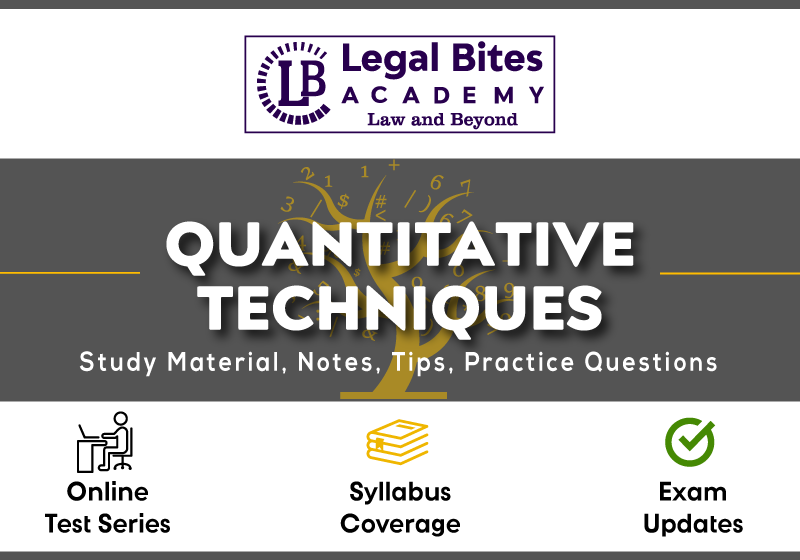How to Approach Quantitative Techniques Questions for CLAT
Introduction Approaching the quantitative techniques section of the paper might look scary but is not. The section is tricky and a bit time-consuming but if practiced and approached the right way this section consists of elementary level quantitative analysis questions. Although this section takes time to finish since each question has to be analyzed, this section boosts up… Read More »

Introduction Approaching the quantitative techniques section of the paper might look scary but is not. The section is tricky and a bit time-consuming but if practiced and approached the right way this section consists of elementary level quantitative analysis questions. Although this section takes time to finish since each question has to be analyzed, this section boosts up the overall score. The quantitative Techniques section has a weightage of nearly 10% of CLAT Paper. The questions...
Introduction
Approaching the quantitative techniques section of the paper might look scary but is not. The section is tricky and a bit time-consuming but if practiced and approached the right way this section consists of elementary level quantitative analysis questions. Although this section takes time to finish since each question has to be analyzed, this section boosts up the overall score.
The quantitative Techniques section has a weightage of nearly 10% of CLAT Paper. The questions will require you to:
- Derive, infer, and manipulate numerical information set out in such passages, graphs, or other representations; and
- Apply various 10th standard mathematical operations on such information, including areas such as ratios and proportions, basic algebra, mensuration and statistical estimation.
How to Approach Quantitative Techniques Questions for CLAT
- You may also be required to answer questions in the field of data interpretation, such as those that require you to analyse histograms, charts, tables, and other graphical information, and questions from areas of Tenth standard mathematics.
- As budding lawyers, CLAT Consortium is hopeful that the candidate will cultivate the capacity to separate useful from not useful information and to be able to use the information to draw conclusions. This is a skill you will have to practice often over your career.
- Rather than the complexity of calculation, the consortium is focused on your ability to find and manipulate relevant information comfortably.
- Since the Quantitative Techniques section of the UG CLAT 2021 differs from previous years’ papers in that it requires you to read a passage or analyse a set of graphical information before attempting a question, it is very important that you go through the passage provided, or the graphical information supplied to you, and list out (or underline) the information that is provided to you, and the information that you may need to answer the questions. As a simple example, a passage may provide the various speeds of trains, and the distance between two stations – in this case you know that you will probably need to calculate the time such trains may take to cover such distances.
- Again, since the Quantitative Techniques section of the UG CLAT 2021 follows the general trend of changes in the CLAT towards a more comprehension-based format, it is important that you read the passages and questions very carefully, so as to ensure you have understood the information supplied, and what exactly the question is asking of you. Bear in mind that the question setters would tend to move away from formulae-based questions towards more logic-based questions – this means that they are not only looking at your ability to conduct simple mathematical calculations, they are also looking for your ability to analyze the passages and graphical information.
- Quite often, a later question in any set of questions in the Quantitative Techniques section of the UG CLAT 2021 will require you to use some information that you may have calculated or derived in the course of answering a previous question. Since this is the case, it is important that you keep your rough notes and calculations neat and handy, so that you can quickly refer to such information when needed. Since the UG CLAT 2021 is, among other things, a test of your ability to answer questions efficiently, it would be a terrible waste of time if you had to hunt through your rough notes and calculations to find some vital piece of information.
- In some instances, it is very helpful to keep a set of rough notes where you list out the main people, objects, or artefacts that the question relates to (such as trains, boats, vessels, etc.), and keep listing out relevant information relating to each of them as you go along – for example, in a question about time, speed, and distance, it is very useful to have information such as the length of a train, its speed, and what time it leaves a station, readily available. Not only will this save you time, it will also help avoid any mistakes in going back and forth across your notes to find some information that you had derived some time back.
Source: Official Website – Consortium of National Law Universities, Available Here

Admin Legal Bites
Legal Bites Study Materials correspond to what is taught in law schools and what is tested in competitive exams. It pledges to offer a competitive advantage, prepare for tests, and save a lot of money.
